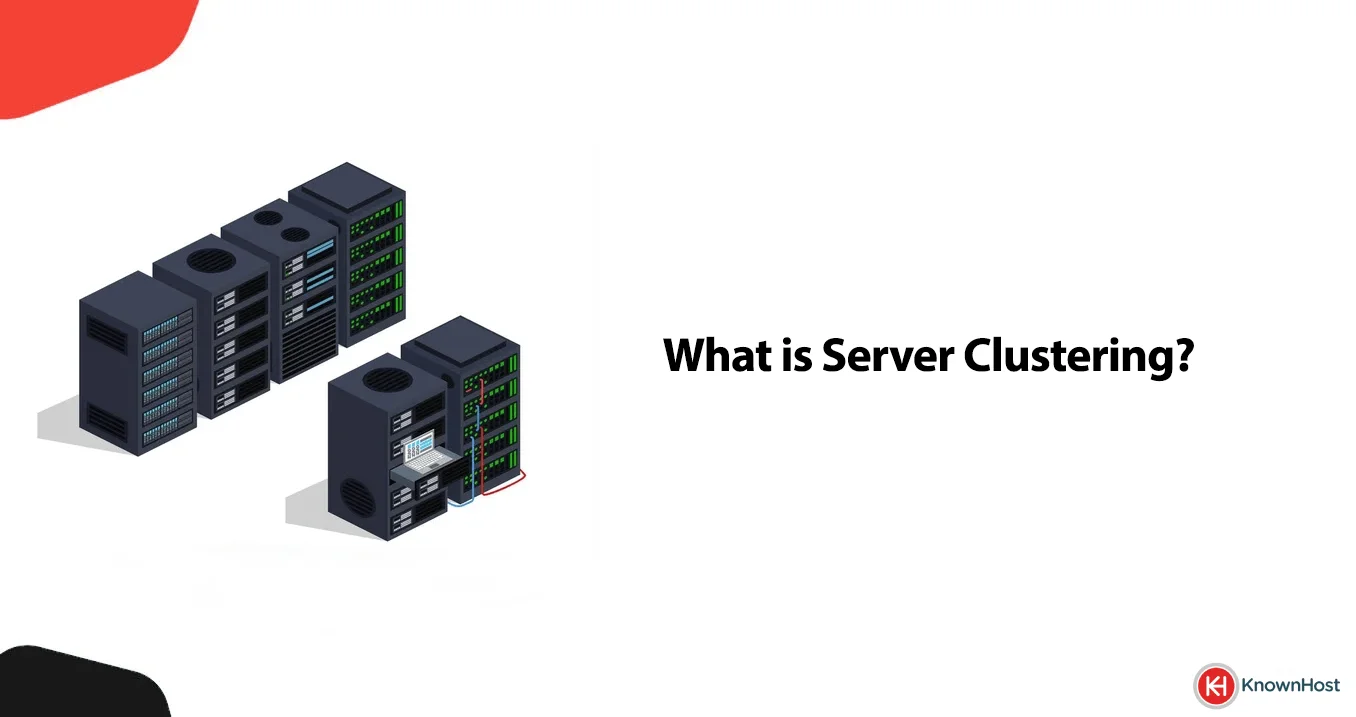What is Server Clustering?

Hardware and software failures can be a huge issue when it comes to tech. When one of these faults occurs, it can often lead to widespread losses of service and data protection issues – resulting in a loss of capital for a business and an army of unhappy customers.
This is where server clustering proves its worth. Server clustering is a method of deploying servers to protect data and keep services running during major failures.
In this guide, KnownHost explains what server clustering is, how it works, and the many benefits of adopting the approach.

What Is Server Clustering and How Does It Work?
Server clustering is a method of server protection that involves deploying multiple servers. When one server fails due to hardware or software issues, another server kicks in to take over the running processes while the other is in disrepair.
It works by grouping two or more servers (known individually as ‘nodes’) under the same IP address. Each node has a CPU, hard drive, and RAM. These nodes are often stored on common disks or a disk array (storage systems). When one node fails, another node takes over its processes, while the failed node is repaired by technical staff.
For example, imagine a website hosting service experiences a technical fault in three out of eight nodes within a server cluster. Instead of the entire service going down, there’s enough capacity in the other five nodes to handle these processes, and they can be transferred over to the remaining nodes while the faulty ones are repaired.
Server Clusters are important because they provide a continual service with minimal downtime and interruptions in the face of application, hardware, or website failure.
What Are the Benefits of Server Clustering?
Server Clustering can provide a business with a host of benefits for their database of live services:
- Scalability: One server is required to handle every key process of an online business or live service, from the network connection to data storage. When deploying a clustered server infrastructure, it can increase the flexibility and scalability of that server, adding or taking away nodes to suit the capacity needed to keep up with business demands.
- Availability: When one node fails, others can plug the gaps to keep a live service or database functioning with as little downtime as possible. This is important for businesses that require a consistent operational service to generate revenue, like a website hosting service or live gaming server.
- Performance: A clustered server environment can also improve performance, with large amounts of available space and the added benefit of scalability meaning this space can always be increased to meet demand.
- Reduced Costs: By preventing downtime, a clustered server environment can reduce the costs to a business when services aren’t fully operational. When servers are less vulnerable to failure, they’re less likely to cost the business in lost custom, reduced productivity, and reputational damage.
- Customizable Infrastructure: Clustered servers are customizable, with companies able to control how many server clusters they have functioning, and how many nodes within those clusters need to be operational. It allows the business to assess the costs of running its service to maximize cost-efficiency and reduce unnecessary server costs for unused space.
When Is Server Clustering Used?
Server clustering is often used by businesses with many online users or secure data, that need to make sure the service remains operational even during an IT failure. It’s an essential method of server structure for any service relying on being operational.
One example of this would be a hospital database, where critical patient information must be available at all times. So, when a single node goes down, the entire system doesn’t collapse, and doctors can still access patient records during an emergency.
Another example would be a live service game, like an online multiplayer game, in which players stay logged in for consecutive periods, and playability relies on a stable connection with the server. If the server goes down without being in a cluster, then that service is lost for thousands of angry players. If a node within a larger server cluster goes down, however, players may only experience minor disconnections at best, while the technical staff work on recovering that node.
What Are the Types of Server Clusters?
When it comes to server clusters, there are three main types with unique purposes and benefits.
Single Quorum Cluster
The single quorum cluster is one of the most frequently used cluster types. It consists of multiple nodes, with one or most cluster disk arrays all attached to a single connection device (commonly referred to as a bus, SCSI, or fibre). One server manages each of the individual cluster disk arrays within the greater architecture of the cluster.
As long as at least 50% of the nodes within a single cluster remain functional, the cluster itself (and by extension the service provided) will continue to function. A single quorum cluster is one of the easier clusters to set up and will work for any standard hosting service, be it a database or live service.
Majority Node Set Cluster
In this version of a cluster, each node owns a separate copy of the cluster’s configuration data. This type of cluster doesn’t rely on a single bus to function, with each node storing a local duplication of the quorum data.
This model primarily works better for individual servers that are in different geographic locations. For example, an online multiplayer game hosting servers for players in Asia, Europe, and North America will need localized servers.
Single-Node Cluster
Single-node clusters are mainly used for testing purposes and – as the name suggests – contain a single node. While unfit for hosting live services, they’re often used for research, development, and testing purposes.
Due to their limited nature and poor ability to deal with node failure, they’re recommended for testing purposes only. For commercial server clusters, it’s recommended a company use single quorum clusters while selecting majority node clusters only if the international nature of service requires it.
How To Resolve Common Challenges with Server Clustering
There are several main challenges when it comes to setting up and running a server cluster, all of which have simple and effective solutions.
Applications (Service) Failures
Software failures are issues that arise when the software of the application itself encounters runtime errors and other problems. Application failures are unavoidable and will at some point happen to a server.
It’s important to keep an eye on when an application error occurs, make a note of it and then respond quickly and efficiently to have as little downtime as possible. Application failures can be detected by monitoring end-user response times or using an application monitoring tool (such as Sentry, Airbrake, or LogRocket) that records and logs any major application failures.
Hardware (System) Failures
Hardware failures arise from a fault in the underlying technology powering the software (such as the nodes themselves or disk arrays). These issues can be caused by poor heating, software optimization, or storage.
Always consider air flow when setting up a physical server cluster. While the cluster is designed to avoid total system failure, if the area isn’t properly ventilated, the nodes will begin to overheat. This will cause problems in the long run (like replacing parts and data loss) that could be expensive.
Site Failures
A site failure is a large over-arching loss of service linked to the website itself, service, or connection. While server clusters can mitigate downtime for hardware and application errors, they have a harder time dealing with site errors and staff must designate fixing them as a priority task.
Understanding the reason why the site failure took place is the best way to effectively counter it. Sometimes sites go down from a traffic overload, sometimes it’s a hosting error and oftentimes it’s a malicious attack.
As an example, many players want to log in to a new online multiplayer game, more than the service provider had initially anticipated. Because of this, the servers are overloaded with too many players and the site goes down.
The best way to mitigate this risk is to always have a service team on standby in case the site fails but also to prepare to be agile in terms of scalability in server clusters, allowing for increases in capacity depending on the number of users.
What Are Some Technologies Used Within Server Clustering?
Here, we look at some of the key technologies in the server clustering infrastructure that allow businesses to enjoy seamless and consistent services:
- Checkpoint Manager: Checkpoint managers are used within server clusters to update registry data about a resource being offline and failover unaware applications. This is important because it keeps a constant tally of which nodes have failed and which needs a failover (taking on the processes of a failed node).
- Communications Manager: The communications manager facilitates the exchange of information between the nodes and the cluster itself utilizing Remote Procedure Calls (RPCs) – a type of software that allows a program to request services from another program located in a different computer. It also handles cluster connection attempts.
- Failover Manager: When a node fails, the failover manager determines which working node shall resume the application processes.
- Event Log Manager: Makes sure that every node in the cluster has the same available event log information.
- Resource Monitor: Makes sure that the individual resources in a cluster are functioning correctly. It also starts and stops resources, and enacts resource failover.
At KnownHost, we offer effective and affordable web hosting services that make use of server clustering to offer 99.99% network uptime. We also boast an effective and dedicated support team, as well as secure hosting.
Don’t believe us? Here’s what one of our clients had to say:
‘Customer service is superb, industry-leading I’d say. Infrastructure is good, reliable and very cost-effective.’ – Webifica
For more information on server clustering and how we can support all your web hosting needs, chat with our expert team today.
Frequently Asked Questions (FAQ)
Q: How to Create A Server Cluster?
A: A simple server cluster can be created in one of four steps. First, connect cluster servers to networks and storage, then install the failover cluster features. Next, validate the cluster configuration before finally creating the cluster itself.
Q: How Many Servers Make a Cluster?
A: There is no set number of servers that make up the perfect server cluster, and by its definition clusters are infinitely scalable. However, a cluster is only considered a cluster when there are a minimum of two nodes within it. However, three nodes are the recommended minimum.